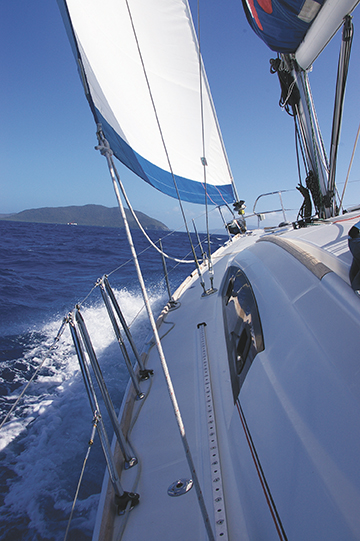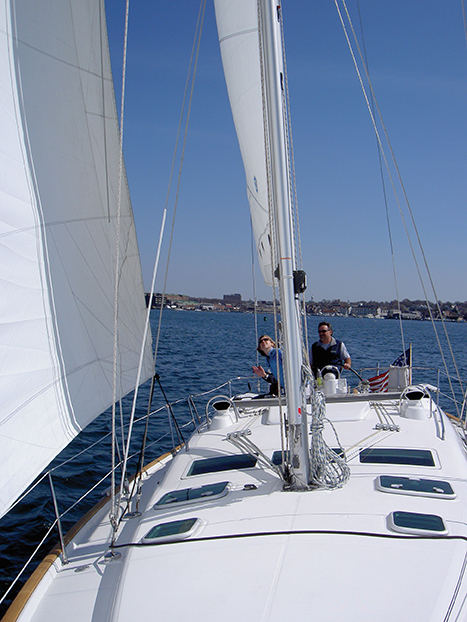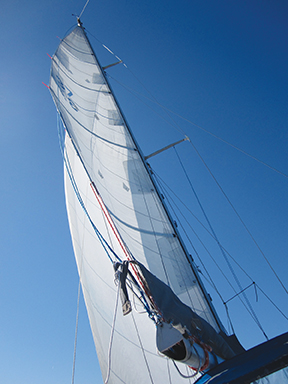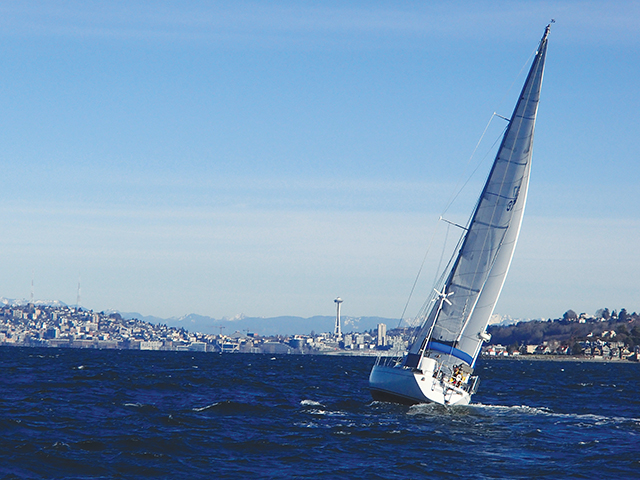Tips and tricks for trimming your sails upwind (published June 2014)
While leading a flotilla of six boats in the Caribbean, we had a day of sailing to windward from our anchorage in Montserrat to Jolly Harbour, Antigua and the wind was suppose to build as the day progressed. Based on the rhumb line and forecasted wind direction, I could tell that if we all sailed well close hauled, we might just make it without having to tack.
My plan was to leave early in the moderate breeze, which would give us some excellent close hauled sailing and build in some cushion before needing to tuck in a reef or two. And if all the boats were sailed to their potential, I knew we could easily make it to Jolly Harbour before the brunt of the wind arrived.
The skippers on the other boats were average cruisers with a good amount of experience and crews who had learn-to-sail through advanced skills. Very quickly, though, once we got out and headed to our destination, all five of the other boats started footing off onto a close reach and in just a few miles, our boat ended up well in front and to windward of the fleet.
The problem: every boat needed to trim their sails and steer better if they expected to make it to Antigua in a reasonable amount of time. As we sailed I took note of their sail trim and offered up some tips and advice on upwind sailing over sundowners when we reached our anchorage.
So, here are some of those tips and a few more to help you sail faster and more efficiently upwind.
TIGHTEN YOUR SAILS

There are two little sayings in sailing that, while appropriate some of the time, can often be misunderstood: “When in doubt, let it out” and “Set it and forget it.” The first only applies when you are reaching and need to twist the sails open enough to see them luff and then trim them back in until that luffing stops. The second disregards the many advantages that we have aboard to help us use the sails more efficiently.
The reason all five boats in the flotilla were footing off was because their sails were just too far out. The main and jib sheets were eased so much that the top thirds of the sails were twisted wide open and spilling air. So when they tried to point high, the sails luffed and their boat speed would stall. This sail trim would be great if close reaching or when sailing in lighter wind, but not close hauled in a moderate 10 to 15 knot breeze.
When sailing upwind we need to bring our sails in tight to make them a more effective foil shape for the given sailing angle, thus, making them more efficient. When the wind breaks around each side of the sails we want it to do so evenly and stay attached as long as possible—this is where tell tales come in handy. Luffing sails and poorly trimmed sails will cause the airflow to become turbulent and ineffective.
With the sails in tight, though, the boat can tend to get overpowered as the wind picks up, which is what we were trying to avoid by leaving early. This is where good communication between the trimmers and helmsman needs to happen. If the boat is heeling uncomfortably and there is too much weather helm, it’s time to release some pressure from the sails or possibly tuck in a reef.

CONTROLLING POWER
We all know from Sailing 101 that sail shape is similar to a throttle. In general, flat sails have less power and deep, full sails have more power. Reefing is a great option if you are obviously too overpowered. But by using the mainsheet, halyard, cunningham, outhaul, backstay, boom vang, traveler and jib fairleads you can, and should, shape your sails to depower or power them up.
When trimming for efficient upwind sailing I like to start with the headsail first. The jib or genoa needs to be tight to sail well upwind and the fairleads are going to dictate how powerful the sail is by controlling tension on the foot and leech. Move the car aft and you will decrease power by putting tension on the foot, which flattens the bottom of the sail and twists open the top. Move the car forward and you will increase power by tensioning the leech and giving the sail a deeper shape.
Potential jib trimming pitfalls generally have to do with over or under sheeting. Over sheet the jib and you will throw air back into the main, which will cause it to luff. Under sheet and the sail will twist too far open and luff at the top—both are slow and inefficient. A good way to judge jib trim is to give the leech a nice vertical shape from the clew to the shoulder. This will ensure it isn’t twisted open too far or in too tight.
When getting overpowered it is tempting to roll up part of the headsail. In reality, though, this turns the sail into a horribly ineffective shape that can be just as powerful as the full sail. Most times, reefing the main first, or twice, is a better option.
 Once the jib is trimmed we can work aft to shape the mainsail starting with the mainsheet. We all know that the mainsheet trims the boom and sail in and out, but it also allows you to control power by creating twist. At some point when you are pulling the mainsheet tight the boom stops coming in, and instead, starts to come down. This is when we start to close off the leech and get rid of twist. To create twist and decrease pressure, ease the sheet. This is where the crews in our flotilla ran into trouble. They had the right idea by twisting the sails open, but ended up twisting them so far open that they were luffing—not an efficient or fast way to sail upwind.
Once the jib is trimmed we can work aft to shape the mainsail starting with the mainsheet. We all know that the mainsheet trims the boom and sail in and out, but it also allows you to control power by creating twist. At some point when you are pulling the mainsheet tight the boom stops coming in, and instead, starts to come down. This is when we start to close off the leech and get rid of twist. To create twist and decrease pressure, ease the sheet. This is where the crews in our flotilla ran into trouble. They had the right idea by twisting the sails open, but ended up twisting them so far open that they were luffing—not an efficient or fast way to sail upwind.
With your halyards, the general rule is that the stronger the wind the tighter you want them to be. If they are too loose, the draft, or camber, in your sails will become too deep and move aft, which will give the sail a poor foil shape.
Doing the opposite task of the main halyard, the cunningham allows you to tighten the luff of the sail so you can create an optimum foil shape by moving the draft fore or aft. The ideal location is just forward of center.
The outhaul is a ubiquitous control that can be found on everything from dinghies to chartered cruisers. It is the primary flattener for most sails—including in-mast furling sails—and will have an enormous influence on the mainsail’s overall shape and power. The one caveat to it, though, is that it pretty much only controls shape and power in the bottom third of a sail.
An adjustable backstay is where you would go to control shape in the top two thirds of your mainsail. Many cruising boats don’t have adjustable backstays, but it would be nice if they did because it really does help. By tightening an adjustable backstay you are able to flatten the top two thirds of the main, which will also cause it to twist open just slightly. Doing this releases a large amount of pressure off the top of the rig and can greatly reduce weather helm and heeling. Some sailors will go so far as to tighten everything else and just play the backstay to control power while going upwind. Tightening the backstay will also put tension on the luff of the jib, which will help keep the draft forward as well.
The boom vang’s primary job is to keep the boom from rising up when sailing on a reach or a run, but we can use it while sailing upwind, too. By increasing or decreasing vang tension we are adjusting pressure on the leech of the mainsail. The mainsheet also does this, but the vang can be a fine tuner. Once the mainsheet is set tight, try trimming the vang a little to close the leech, or ease it some to give the sail a little bit of twist.
One of the most effective sail controls available is the traveler. The traveler allows you to swing the boom from side to side like a door and will be one of the first things to go to when starting to get overpowered. By keeping the mainsail’s leech tight and easing the traveler to leeward, you are changing the sail’s angle of attack to the wind and releasing pressure, while still maintaining an efficient shape. Conversely, in light wind you may want to bring the traveler to windward and twist the sail open to give it more pressure and power.
STEER CLEAR
Steering is just as important as proper sail trim and when done correctly, the two are really working in concert to make the boat sail well. By controlling how much power is in your sails you are allowing the boat to stay balanced, which makes it easier for the person on the helm to steer the boat. If the boat is overpowered it becomes hard to steer and the rudder creates a lot of turbulence and drag, which is slow. Again, make sure to communicate as to how the helm is feeling and if you are getting too much weather helm, reduce power in the boat.
 SHAPE UP
SHAPE UP
Unfortunately, sail shape doesn’t last forever. As our sails are exposed to salt, sun and luffing they become a blowout, inefficient shape and the only thing to do is to purchase a new suit. New sails will not only look good, but the reward you will get by having new foils will really help teach you about all the sail controls when you go to use them.
When deciding on a new set of sails, talk to your sailmaker about your sailing style and what kind of performance you would like to achieve. Also, once you’ve purchased a new set of sails, it is a good idea to take the sailmaker out and go through all the sail shaping controls to see how they respond to your trimming prowess.
Just like the members of our Caribbean flotilla, sail trim and shape doesn’t come naturally or overnight and there is always something to learn. Only by going out in a variety of conditions and practicing with all your sail controls can you really get a feel for how your boat responds. Merely “setting it and forgetting it” isn’t usually the way to becoming a better upwind sailor.

















